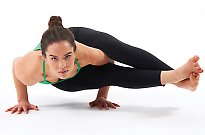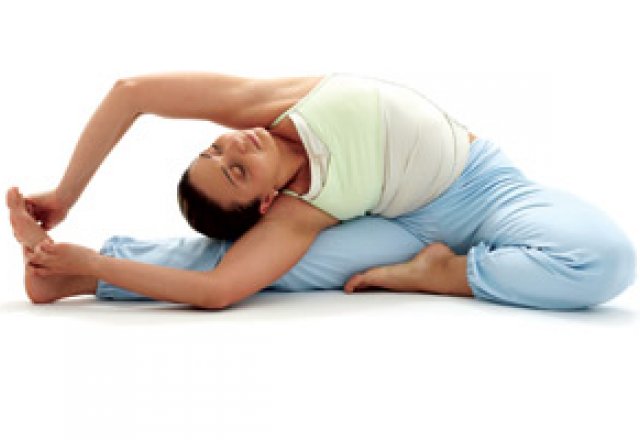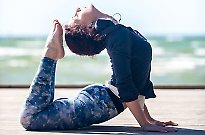
Ashtanga yoga

Improve your health
Yogi Amanda Ferris talks about a vigorous yoga practice that is not for the faint hearted
When did you start practising yoga?
I began learning yoga when I was five years old. Regular, disciplined practice became a habit when I was 19 and I have cultivated uninterrupted daily practise for the last 15 years.
Tell me about your
chosen style.
I practise Ashtanga yoga in the tradition of Sri K. Pattabhi Jois. As yogis, we aspire to states of meditation, absorption and bliss known as dharana, dhyana and samadhi. For these states to be even vaguely possible, one’s body needs to be strong and healthy and one’s mind needs to be clear and undisturbed.
In pursuit of health and a clear mind, we engage in actions that create this potential. The important components of Ashtanga yoga are vinyasa and yoga tristhana. Vinyasa is a system of movement and breathing linked together; it produces heat in the body and this is desirable because heat burns toxins stored in the body. Yoga tristhana is three things: asana or yoga postures that purify the body, drishti or gazing points that through practice purify the mind, and a breathing system that purifies the nervous system. Another important feature of traditional Ashtanga yoga is parampara. Parampara is the passing of knowledge from teacher to student. For yoga to be effectively learned, a student-teacher relationship is essential. It takes many years for the teachings to be correctly absorbed. In our tradition, one is not recognised as a teacher until Sharath Rangaswamy, Pattabhi Jois’ grandson, offers authorisation or certification to teach the method. I am sought out by people who want to learn this method and I willingly share what I know. However, in my own eyes, I am a humble and devoted student of Ashtanga yoga.
Why did you choose to study and teach Ashtanga?
It made sense to me. It felt both ancient and alive, and it is! I am both a practical and heart-focused, spiritual person. Ashtanga yoga spoke to me on both levels immediately, and it continues to appeal to me in these ways. On a personal level this has been important because it has not always been easy for me to match the longings of my heart with the opinions in my head. This practice allows space for both my heart and my head and I am a more integrated person as a result.
Who has been your most influential teacher?
Sri K. Pattabhi Jois, who is affectionately called “Guruji” around the globe, taught Ashtanga yoga for more than 60 years and is responsible for its spread into the West. I am fortunate to have studied with him and his grandson, Sharath Rangaswamy, several times before Pattabhi Jois died in 2008. Pattabhi Jois strongly influenced me both directly and indirectly via his long-time, cherished student Dena Kingsberg. I spent six and a half years in her classroom, first as a practitioner, then trainee, then apprentice. I don’t see her as often as I’d like to, but she is in my thoughts daily and is my teacher, mentor and dear friend.
What do you enjoy most about yoga?
It's too difficult for me to name one thing. I enjoy the effects of conscious breathing. I enjoy the lightness of my body and the feeling of flight. I enjoy the act of listening with my heart. I enjoy being inspired again and again and again. I enjoy a mind that works. I enjoy my life. I enjoy knowing that I have tools to find my way when it gets tough.
What are some of the changes you’ve seen in your practice over
the years?
It’s more subtle now. In the beginning there was a lot of unnecessary effort. Also a lot of fanfare and excitement. My passion for practice is as strong as ever. However, I am more grounded in it. It is a very real, daily ritual I go through with the intention of cleaning my internal body, clearing out my head, and pushing emotions up and out so they do not become stuck and toxic for me. I do this in the hope of being ripe to know God.
How has yoga helped you?
Yoga has helped me carve out a place inside myself where I can rest and contemplate life in a balanced way. Through yoga, I am grounded and unlikely to panic in the face of adversity or challenge. Through yoga, equally, I am light and unlikely to droop heavily for long periods.
How can yoga help with modern mental and physical ailments?
There are many ways yoga can help. As a city dweller, I am aware of a heightened need for mental space. I ride commuter trains and I notice that riders mostly have their ears covered with headphones and, more recently, their eyes are absorbed by smartphones and other devices. The senses are not all available to the world around. I understand the need to retreat from constant stimulation. Yoga can make it easier to turn inwards and draw energy in, rather than always sending it outwards as we engage with the world around. If we regularly practise finding internal space, it’s easier to find it when you really need it.
Browse more health advice or join the debate on our Facebook page.


